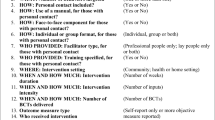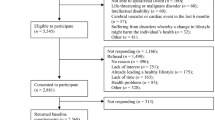Abstract
In order to address the growing burden of chronic diseases in the Americas, the Pan American Health Organization implemented the Women as Agents of Change project in Panama and Trinidad & Tobago. The project focused on low income, middle aged women and promoted increased physical activity, intake of 5 servings of fruits and vegetables daily, and yearly screening for cervical cancer. One hundred women per country participated in the 6 week program which consisted of weekly meetings and participation in a behavior change curriculum. Gollwitzer’s theory of implementation intentions and the theory of social support provided the methodology for the design of the curriculum. At baseline, end of project, and at 6 months, participants completed physical activity and fruit and vegetable consumption surveys. Results show an increase in consumption in Panama between the pre and post-tests, though the increase was not maintained at the 6 month period. Physical activity decreased in both countries over the intervention period, likely due to misreporting on the pretest. Notably, most participants reported on the 6 month follow up survey that they had continued or intensified the behavior changes they undertook during the project. The paper describes barriers identified by the participants as well as strategies they devised to overcome them.
Similar content being viewed by others
References
World Health Organization. (2003). The World Health Report 2003—Shaping the Future. World Health Organization, Geneva, Switzerland
Pan American Health Organization. Health in the Americas: 2002 edition. Washington, DC: PAHO, 2002
Stewart BW, Kleihues P (eds.), World Cancer Report. Lyon: IARCPress, 2003, pp 12, 24
World Health Organization. (2002) The World Health Report 2002—Reducing Risks, Promoting Healthy Life. World Health Organization, Geneva, Switzerland
Beaglehole R, Yach D. (2003). Globalization and the prevention and control of non-communicable disease: the neglected chronic diseases of adults. Lancet 362:903–908
Yach D, Hawkes C, Gould C et al. (2004). The Global Burden of Chronic Diseases.JAMA 291:2616–2622
World Health Organization. (1990). Diet, Nutrition, and the Prevention of Chronic Disease: Technical Report Series no. 797. WHO, Geneva, Switzerland
Anderson JV, Bybee DI, Brown R et al. (2001) 5 a day fruit and vegetable intervention improves consumption in a low income population. J Am Diet Assoc 101:195–202
Havas S, Anliker J, Damron D, Langenberg P, Ballesteros M, Feldman R. (1998). Final results of the Maryland WIC 5-A-Day Promotion Program. Am J Public Health 88:1161–1167
Beresford SA, Shannon J, McLerran D, Thompson B. (2000). Seattle 5-a-Day Work-Site Project: process evaluation. Health Educ Behav 27:213–222
Maxwell AE, Bastani R, Vida P. (2002). Physical Activity among Older Filipino-American Women. Women Health 36:67–79
Anderson AS, Cox DN, McKellar S, Reynolds J, Lean ME, Mela DJ. (1998). Take Five, a nutrition education intervention to increase fruit and vegetable intakes: impact on attitudes towards dietary change. Br J Nutr 80:133–140
Navarro AM, Rock CL, NcNicholas LJ, et al. (2000). Community-based Education in Nutrition and Cancer: The Por la Vida Cuidándome Curriculum. J Cancer Edu 15:168–172
World Bank. (2004). World Development Report 2004. World Bank, Washington DC
FAO. Nutrition Country Profiles: Panama and Trinidad & Tobago. http://www.fao.org/es/ESN/nutrition/profiles_en.stm. Accessed 9/20/04
Oxaal Z, Baden S. Gender and Empowerment: definitions, approaches, and implications for policy. Bridge Report No. 40. Sussex: Institute of Development Studies, 1997
Inter-Agency Secretariat of the International Strategy for Disaster Reduction (UN/ISDR). Living with Risk : A global review of disaster reduction initiatives. 2004 version. Geneva, Switzerland: United Nations ISDR, 2004
International Fund for Agricultural Development. Women as Agents of Change. Discussion Paper. http://www.ifad.org/gbdocs/gc/26/e/women.pdf. Accessed 9/15/04
UN Commission on the Status of Women Forty-eighth Session 4th & 5th Meetings. Women’s equal participation in peace processes, men’s role in achieving gender equality addressed by women’s commission in two panel discussions. Press release. 02/03/2004
Bruce J, Lloyd CB. (1997). Finding the ties that bind: beyond headship and household. In: Haddad L, Hoddinott J, Alderman H (eds.), Intrahousehold Resource Allocation in Developing Countries: Models, Methods and Policies. International Food Policy Research Institute, Washington D.C, pp. 217
Engle PL. (1990). Intra-household allocation of resources: perspectives from psychology. In: Rogers BL, Schlossman NP (eds.), Intra-Household Resource Allocation: Issues and Methods for Development Policy and Planning. The United Nations University, Tokyo
Randolph WM, Freeman DH, Freeman JL. (2002). Pap smear use in a population of older Mexican-American women. Women Health 36:21–31
Claeys P, Gonzalez C, Gonzalez M, et al. (2002). Determinants of cervical cancer screening in a poor area: results of a population-based survey in Rivas, Nicaragua. Trop Med Int Health 11:935–41
Horiuchi S, Finch CE, Mesle F, Vallin J. (2003). Differential patterns of age-related mortality increase in middle age and old age. Gerontol A Biol Sci Med Sci 58:495–507
Gollwitzer PM. (1999). Implementation Intentions: Strong Effects of Simple Plans. Am Psychol 54:493–503
Orbell S, Sheeran P. (1997). Implementation intentions and the theory of planned behavior. Pers Soc Psychol Bull 23:945–954
Milne S, Orbell S, Sheeran P. (2002). Combining motivational and volitional interventions to promote exercise participation: protection motivation theory and implementation intentions. Br J Health Psychol 7(Pt 2):163–184
Sheeran P, Orbell S. (2000). Using Implementation Intentions to Increase Attendance for Cervical Cancer Screening. Health Psychol 19:283–289
Berkman LF. (1995). The role of social relations in health promotion. Psychosom Med 57:245–54
Zhu K, Hunter S, Bernard LJ, Payne-Wilks K, et al. (2000). Mammography screening in single older African-American women: a study of related factors. Ethn Dis 10:395–405
Suarez L, Ramirez AG, Villarreal R, et al. (2000). Social networks and cancer screening in four US Hispanic groups. Am J Prev Med 19:47–52
Sanderson BK, Foushee, HR, Bittner V. (2003). Personal, social, and physical environmental correlates of physical activity in rural African-American women in Alabama. Am J Prev Med 25:30–37
Thrasher JF, Campbell MK, Oates V. (2004). Behavior-specific social support for healthy behaviors among African American church members: applying optimal matching theory. Health Educ Behav 31:193–205
Levy-Storms L, Wallace SP. (2003). Use of mammography screening among older Samoan women in Los Angeles County: a diffusion network approach. Soc Sci Med 57:987–1000
Taylor SE, Klein LC, Lewis BP, et al. (2000). Biobehavioral responses to stress in females: tend-and-befriend, not fight-or-flight. Psychol Rev 107:411–429
International Physical Activity Questionnaire. Spanish version. http://www.ipaq.ki.se/ Accessed 9/01/02
FAO. Nutrition Country Profiles: Panama http://www.fao.org/es/ESN/nutrition/pan-e.stm. Accessed: 8/15/04
Birmingham B, Shultz JA, Edlefsen M. (2004). Evaluation of a Five-A-Day recipe booklet for enhancing the use of fruits and vegetables in low-income households. J Community Health 29:45–62
Young DR, Haskell WL, Taylor CB, Fortmann SP. (1996). Effect of community health education on physical activity knowledge, attitudes, and behavior. The Stanford Five-City Project. Am J Emidemiol 144:264–274
Dunn, AL, Marcus, BH, Kampert, JB. (1999). Comparison of Lifestyle and Structured Interventions to increase Physical Activity and Cardiorespiratory Fitness. JAMA 281:327–334
Harland J, White M et al. (1999). The Newcastle exercise project: a randomized controlled trial of methods to promote physical activity in primary care. BMJ 319:828–832
Boutelle KN, Jeffrey RW, French SA. (2004). Predictors of vigorous exercise adoption and maintenance over four years in a community sample. Int J Behav Nutr Phys Act 1:13
Acknowledgments
This project was supported by the Pan American Health Organization, in collaboration with Ministries of Health of Panama and Trinidad & Tobago. The authors wish to thank Dr. Sylvia Robles, Dr. Gina Watson, and the public clinic health staff in our project sites for their invaluable contributions to the project.
Author information
Authors and Affiliations
Corresponding author
Additional information
Sarah C. White, MA is a Technical Officer at the Pan American Health Organization in Washington, DC; Irene Agurto, PhD is an Independent Consultant in Santiago, Chile; and Nuria Araguas, MA is an Independent Consultant in Panama City, Panama.
Rights and permissions
About this article
Cite this article
White, S.C., Agurto, I. & Araguas, N. Promoting healthy behaviors to prevent chronic disease in panama and trinidad & tobago: results of the women as agents of change project. J Community Health 31, 413–429 (2006). https://doi.org/10.1007/s10900-006-9022-8
Published:
Issue Date:
DOI: https://doi.org/10.1007/s10900-006-9022-8




